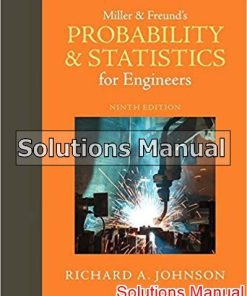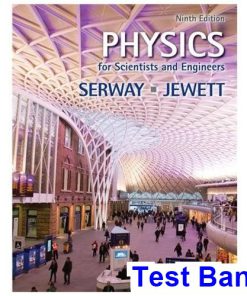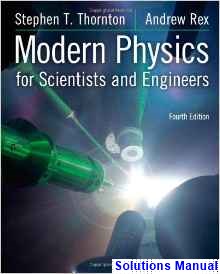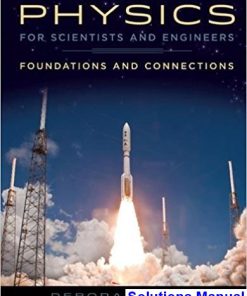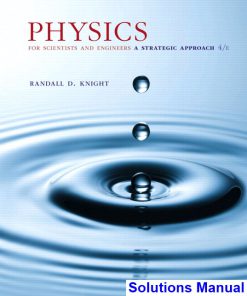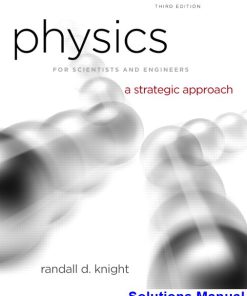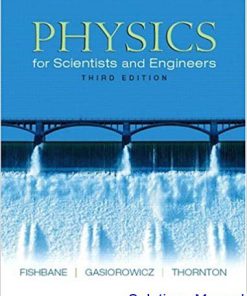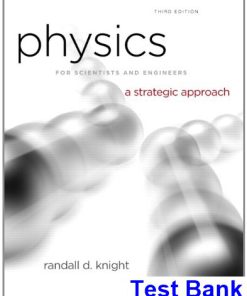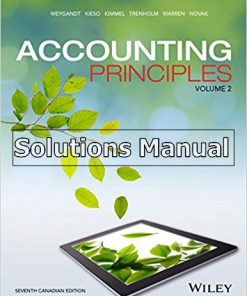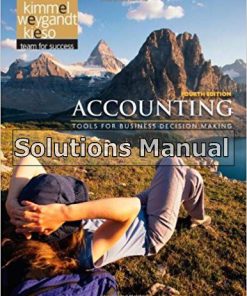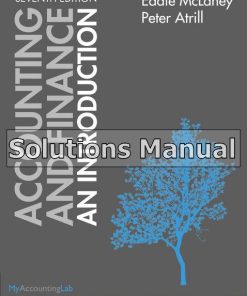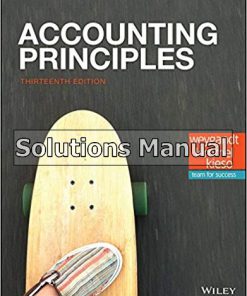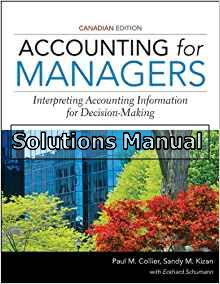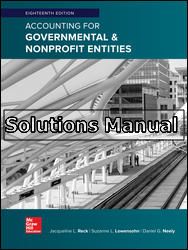Physics for Scientists and Engineers 9th Edition Serway Solutions Manual
$50.00 Original price was: $50.00.$26.50Current price is: $26.50.
Physics for Scientists and Engineers 9th Edition Serway Solutions Manual.
This is completed downloadable of Physics for Scientists and Engineers 9th Edition Serway Solutions Manual
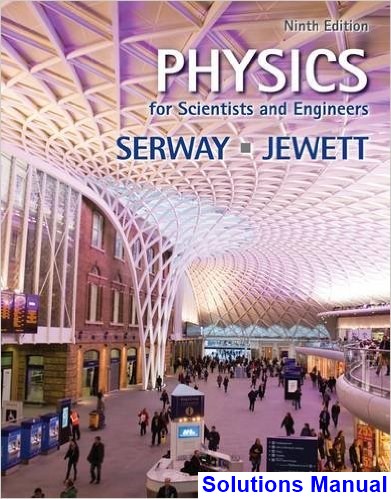
Product Details:
- ISBN-10 : 1133947271
- ISBN-13 : 978-1133947271
- Author: Raymond A. Serway (Author), John W. Jewett (Author)
Achieve success in your physics course by making the most of what PHYSICS FOR SCIENTISTS AND ENGINEERS has to offer. From a host of in-text features to a range of outstanding technology resources, you’ll have everything you need to understand the natural forces and principles of physics. Throughout every chapter, the authors have built in a wide range of examples, exercises, and illustrations that will help you understand the laws of physics AND succeed in your course!
Table of Content:
Contents APPLICATIONS LIST PREFACE AVAILABLE SUPPLEMENTS AND MEDIA NOTES TO STUDENTS (AND INSTRUCTORS) ON THE FORMAT COLOR USE: VECTORS, FIELDS, AND SYMBOLS CHAPTER1: INTRODUCTION, MEASUREMENT, ESTIMATING 1-1 The Nature of Science 1-2 Models, Theories, and Laws 1-3 Measurement and Uncertainty; Significant Figures 1-4 Units, Standards, and the SI System 1-5 Converting Units 1-6 Order of Magnitude: Rapid Estimating *1-7 Dimensions and Dimensional Analysis SUMMARY QUESTIONS PROBLEMS GENERAL PROBLEMS PART 1: MECHANICS CHAPTER 2: DESCRIBING MOTION: KINEMATICS IN ONE DIMENSION 2-1 Reference Frames and Displacement 2-2 Average Velocity 2-3 Instantaneous Velocity 2-4 Acceleration 2-5 Motion at Constant Acceleration 2-6 Solving Problems 2-7 Freely Falling Objects *2-8 Variable Acceleration; Integral Calculus *2-9 Graphical Analysis and Numerical Integration SUMMARY QUESTIONS PROBLEMS GENERAL PROBLEMS CHAPTER 3: KINEMATICS IN TWO OR THREE DIMENSIONS; VECTORS 3-1 Vectors and Scalars 3-2 Addition of Vectors-Graphical Methods 3-3 Subtraction of Vectors, and Multiplication of a Vector by a Scalar 3-4 Adding Vectors by Components 3-5 Unit Vectors 3-6 Vector Kinematics 3-7 Projectile Motion 3-8 Solving Problems Involving Projectile Motion 3-9 Relative Velocity SUMMARY QUESTIONS PROBLEMS GENERAL PROBLEMS CHAPTER 4: DYNAMICS: NEWTON'S LAWS OF MOTION 4-1 Force 4-2 Newton's First Law of Motion 4-3 Mass 4-4 Newton's Second Law of Motion 4-5 Newton's Third Law of Motion 4-6 Weight-the Force of Gravity; and the Normal Force 4-7 Solving Problems with Newton's Laws: Free-Body Diagrams 4-8 Problem Solving-A General Approach SUMMARY QUESTIONS PROBLEMS GENERAL PROBLEMS CHAPTER 5: USING NEWTON'S LAWS: FRICTION, CIRCULAR MOTION, DRAG FORCES 5-1 Applications of Newton's Laws Involving Friction 5-2 Uniform Circular Motion-Kinematics 5-3 Dynamics of Uniform Circular Motion 5-4 Highway Curves: Banked and Unbanked *5-5 Nonuniform Circular Motion *5-6 Velocity-Dependent Forces: Drag and Terminal Velocity SUMMARY QUESTIONS PROBLEMS GENERAL PROBLEMS CHAPTER 6: GRAVITATION AND NEWTON'S SYNTHESIS 6-1 Newton's Law of Universal Gravitation 6-2 Vector Form of Newton's Law of Universal Gravitation 6-3 Gravity Near the Earth's Surface; Geophysical Applications 6-4 Satellites and "Weightlessness" 6-5 Kepler's Laws and Newton's Synthesis *6-6 Gravitational Field 6-7 Types of Forces in Nature *6-8 Principle of Equivalence; Curvature of Space; Black Holes SUMMARY QUESTIONS PROBLEMS GENERAL PROBLEMS CHAPTER 7: WORK AND ENERGY 7-1 Work Done by a Constant Force 7-2 Scalar Product of Two Vectors 7-3 Work Done by a Varying Force 7-4 Kinetic Energy and the Work-Energy Principle SUMMARY QUESTIONS PROBLEMS GENERAL PROBLEMS CHAPTER 8: CONSERVATION OF ENERGY 8-1 Conservative and Nonconservative Forces 8-2 Potential Energy 8-3 Mechanical Energy and Its Conservation 8-4 Problem Solving Using Conservation of Mechanical Energy 8-5 The Law of Conservation of Energy 8-6 Energy Conservation with Dissipative Forces: Solving Problems 8-7 Gravitational Potential Energy and Escape Velocity 8-8 Power *8-9 Potential Energy Diagrams; Stable and Unstable Equilibrium SUMMARY QUESTIONS PROBLEMS GENERAL PROBLEMS CHAPTER 9: LINEAR MOMENTUM 9-1 Momentum and Its Relation to Force 9-2 Conservation of Momentum 9-3 Collisions and Impulse 9-4 Conservation of Energy and Momentum in Collisions 9-5 Elastic Collisions in One Dimension 9-6 Inelastic Collisions 9-7 Collisions in Two or Three Dimensions 9-8 Center of Mass (CM) 9-9 Center of Mass and Translational Motion *9-10 Systems of Variable Mass; Rocket Propulsion SUMMARY QUESTIONS PROBLEMS GENERAL PROBLEMS CHAPTER 10: ROTATIONAL MOTION 10-1 Angular Quantities 10-2 Vector Nature of Angular Quantities 10-3 Constant Angular Acceleration 10-4 Torque 10-5 Rotational Dynamics; Torque and Rotational Inertia 10-6 Solving Problems in Rotational Dynamics 10-7 Determining Moments of Inertia 10-8 Rotational Kinetic Energy 10-9 Rotational Plus Translational Motion; Rolling *10-10 Why Does a Rolling Sphere Slow Down? SUMMARY QUESTIONS PROBLEMS GENERAL PROBLEMS CHAPTER 11: ANGULAR MOMENTUM; GENERAL ROTATION 11-1 Angular Momentum-Object Rotating About a Fixed Axis 11-2 Vector Cross Product; Torque as a Vector 11-3 Angular Momentum of a Particle 11-4 Angular Momentum and Torque for a System of Particles; General Motion 11-5 Angular Momentum and Torque for a Rigid Object 11-6 Conservation of Angular Momentum *11-7 The Spinning Top and Gyroscope *11-8 Rotating Frames of Reference; Inertial Forces *11-9 The Coriolis Effect SUMMARY QUESTIONS PROBLEMS GENERAL PROBLEMS CHAPTER 12: STATIC EQUILIBRIUM; ELASTICITY AND FRACTURE 12-1 The Conditions for Equilibrium 12-2 Solving Statics Problems 12-3 Stability and Balance 12-4 Elasticity; Stress and Strain 12-5 Fracture *12-6 Trusses and Bridges *12-7 Arches and Domes SUMMARY QUESTIONS PROBLEMS GENERAL PROBLEMS CHAPTER 13: FLUIDS 13-1 Phases of Matter 13-2 Density and Specific Gravity 13-3 Pressure in Fluids 13-4 Atmospheric Pressure and Gauge Pressure 13-5 Pascal's Principle 13-6 Measurement of Pressure; Gauges and the Barometer 13-7 Buoyancy and Archimedes' Principle 13-8 Fluids in Motion; Flow Rate and the Equation of Continuity 13-9 Bernoulli's Equation 13-10 Applications of Bernoulli's Principle: Torricelli, Airplanes, Baseballs, TIA *13-11 Viscosity *13-12 Flow in Tubes: Poiseuille's Equation, Blood Flow *13-13 Surface Tension and Capillarity *13-14 Pumps, and the Heart SUMMARY QUESTIONS PROBLEMS GENERAL PROBLEMS CHAPTER 14: OSCILLATIONS 14-1 Oscillations of a Spring 14-2 Simple Harmonic Motion 14-3 Energy in the Simple Harmonic Oscillator 14-4 Simple Harmonic Motion Related to Uniform Circular Motion 14-5 The Simple Pendulum *14-6 The Physical Pendulum and the Torsion Pendulum 14-7 Damped Harmonic Motion 14-8 Forced Oscillations; Resonance SUMMARY QUESTIONS PROBLEMS GENERAL PROBLEMS CHAPTER 15: WAVE MOTION 15-1 Characteristics of Wave Motion 15-2 Types of Waves: Transverse and Longitudinal 15-3 Energy Transported by Waves 15-4 Mathematical Representation of a Traveling Wave *15-5 The Wave Equation 15-6 The Principle of Superposition 15-7 Reflection and Transmission 15-8 Interference 15-9 Standing Waves; Resonance *15-10 Refraction *15-11 Diffraction SUMMARY QUESTIONS PROBLEMS GENERAL PROBLEMS CHAPTER 16: SOUND 16-1 Characteristics of Sound 16-2 Mathematical Representation of Longitudinal Waves 16-3 Intensity of Sound: Decibels 16-4 Sources of Sound: Vibrating Strings and Air Columns *16-5 Quality of Sound, and Noise; Superposition 16-6 Interference of Sound Waves; Beats 16-7 Doppler Effect *16-8 Shock Waves and the Sonic Boom *16-9 Applications: Sonar, Ultrasound, and Medical Imaging SUMMARY QUESTIONS PROBLEMS GENERAL PROBLEMS CHAPTER 17: TEMPERATURE, THERMAL EXPANSION, AND THE IDEAL GAS LAW 17-1 Atomic Theory of Matter 17-2 Temperature and Thermometers 17-3 Thermal Equilibrium and the Zeroth Law of Thermodynamics 17-4 Thermal Expansion *17-5 Thermal Stresses 17-6 The Gas Laws and Absolute Temperature 17-7 The Ideal Gas Law 17-8 Problem Solving with the Ideal Gas Law 17-9 Ideal Gas Law in Terms of Molecules: Avogadro's Number *17-10 Ideal Gas Temperature Scale-a Standard SUMMARY QUESTIONS PROBLEMS GENERAL PROBLEMS CHAPTER 18: KINETIC THEORY OF GASES 18-1 The Ideal Gas Law and the Molecular Interpretation of Temperature 18-2 Distribution of Molecular Speeds 18-3 Real Gases and Changes of Phase 18-4 Vapor Pressure and Humidity *18-5 Van der Waals Equation of State *18-6 Mean Free Path *18-7 Diffusion SUMMARY QUESTIONS PROBLEMS GENERAL PROBLEMS CHAPTER 19: HEAT AND THE FIRST LAW OF THERMODYNAMICS 19-1 Heat as Energy Transfer 19-2 Internal Energy 19-3 Specific Heat 19-4 Calorimetry-Solving Problems 19-5 Latent Heat 19-6 The First Law of Thermodynamics 19-7 Applying the First Law of Thermodynamics; Calculating the Work 19-8 Molar Specific Heats for Gases, and the Equipartition of Energy 19-9 Adiabatic Expansion of a Gas 19-10 Heat Transfer: Conduction, Convection, Radiation SUMMARY QUESTIONS PROBLEMS GENERAL PROBLEMS CHAPTER 20: SECOND LAW OF THERMODYNAMICS 20-1 The Second Law of Thermodynamics-Introduction 20-2 Heat Engines 20-3 Reversible and Irreversible Processes; the Carnot Engine 20-4 Refrigerators, Air Conditioners, and Heat Pumps 20-5 Entropy 20-6 Entropy and the Second Law of Thermodynamics 20-7 Order to Disorder 20-8 Unavailability of Energy; Heat Death *20-9 Statistical Interpretation of Entropy and the Second Law *20-10 Thermodynamic Temperature Scale; Absolute Zero and the Third Law of Thermodynamics *20-11 Thermal Pollution, Global Warming, and Energy Resources SUMMARY QUESTIONS PROBLEMS GENERAL PROBLEMS PART Two: ELECTRICITY AND MAGNETISM CHAPTER 21: ELECTRIC CHARGE AND ELECTRIC FIELD 21-1 Static Electricity; Electric Charge and Its Conservation 21-2 Electric Charge in the Atom 21-3 Insulators and Conductors 21-4 Induced Charge; the Electroscope 21-5 Coulomb's Law 21-6 The Electric Field 21-7 Electric Field Calculations for Continuous Charge Distributions 21-8 Field Lines 21-9 Electric Fields and Conductors 21-10 Motion of a Charged Particle in an Electric Field 21-11 Electric Dipoles *21-12 Electric Forces in Molecular Biology; DNA *21-13 Photocopy Machines and Computer Printers Use Electrostatics SUMMARY QUESTIONS PROBLEMS GENERAL PROBLEMS CHAPTER 22: GAUSS'S LAW 22-1 Electric Flux 22-2 Gauss's Law 22-3 Applications of Gauss's Law *22-4 Experimental Basis of Gauss's and Coulomb's Law SUMMARY QUESTIONS PROBLEMS GENERAL PROBLEMS CHAPTER 23: ELECTRIC POTENTIAL 23-1 Electric Potential Energy and Potential Difference 23-2 Relation between Electric Potential and Electric Field 23-3 Electric Potential Due to Point Charges 23-4 Potential Due to Any Charge Distribution 23-5 Equipotential Surfaces 23-6 Electric Dipole Potential 23-7 E Determined from V 23-8 Electrostatic Potential Energy; the Electron Volt 23-9 Cathode Ray Tube: TV and Computer Monitors, Oscilloscope SUMMARY QUESTIONS PROBLEMS GENERAL PROBLEMS CHAPTER 24: CAPACITANCE, DIELECTRICS, ELECTRIC ENERGY STORAGE 24-1 Capacitors 24-2 Determination of Capacitance 24-3 Capacitors in Series and Parallel 24-4 Electric Energy Storage 24-5 Dielectrics *24-6 Molecular Description of Dielectrics SUMMARY QUESTIONS PROBLEMS GENERAL PROBLEMS CHAPTER 25: ELECTRIC CURRENTS AND RESISTANCE 25-1 The Electric Battery 25-2 Electric Current 25-3 Ohm's Law: Resistance and Resistors 25-4 Resistivity 25-5 Electric Power 25-6 Power in Household Circuits 25-7 Alternating Current 25-8 Microscopic View of Electric Current: Current Density and Drift Velocity *25-9 Superconductivity *25-10 Electrical Conduction in the Nervous System SUMMARY QUESTIONS PROBLEMS GENERAL PROBLEMS CHAPTER 26: DC CIRCUITS 26-1 EMF and Terminal Voltage 26-2 Resistors in Series and in Parallel 26-3 Kirchoff's Rules 26-4 EMFs in Series and in Parallel; Charging a Battery 26-5 Circuits Containing Resistor and Capacitor (RC Circuits) 26-6 Electric Hazards *26-7 Ammeters and Voltmeters SUMMARY QUESTIONS PROBLEMS GENERAL PROBLEMS CHAPTER 27: MAGNETISM 27-1 Magnets and Magnetic Fields 27-2 Electric Currents Produce Magnetic Fields 27-3 Force on an Electric Current in a Magnetic Field; Definition of 27-4 Force on an Electric Charge Moving in a Magnetic Field 27-5 Torque on a Current Loop; Magnetic Dipole Moment *27-6 Applications: Galvanometers, Motors, Loudspeakers 27-7 Discover and Properties of the Electron *27-8 The Hall Effect *27-9 Mass Spectrometer SUMMARY QUESTIONS PROBLEMS GENERAL PROBLEMS CHAPTER 28: SOURCES OF MAGNETIC FIELD 28-1 Magnetic Field Due to a Straight Wire 28-2 Force between Two Parallel Wires 28-3 Definitions of the Ampere and the Coulomb 28-4 Ampere's Law 28-5 Magnetic Field of a Solenoid and a Toroid 28-6 Biot-Savart Law *28-7 Magnetic materials-Ferromagnetism *28-8 Electromagnets and Solenoids-Applications *28-9 Magnetic Fields in Magnetic Materials; Hysteresis *28-10 Paramagnetism and Diamagnetism SUMMARY QUESTIONS PROBLEMS GENERAL PROBLEMS CHAPTER 29: ELECTROMAGNETIC INDUCTION AND FARADAY'S LAW 29-1 Induced EMF 29-2 Faraday's Law of Induction; Lenz's Law 29-3 EMF Induced in a Moving Conductor 29-4 Electric Generators *29-5 Back EMF and Counter Torque; Eddy Currents 29-6 Transformers and Transmission of Power 29-7 A Changing Magnetic Flux Produces an Electric Field *29-8 Applications of Induction: Sound Systems, Computer Memory, Seismograph, GFCI SUMMARY QUESTIONS PROBLEMS GENERAL PROBLEMS CHAPTER 30: INDUCTANCE, ELECTROMAGNETIC OSCILLATIONS, AND AC CIRCUITS 30-1 Mutual Inductance 30-2 Self-Inductance 30-3 Energy Stored in a Magnetic Field 30-4 LR Circuits 30-5 LC Circuits and Electromagnetic Oscillations 30-6 LC Oscillations with Resistance (LRC Circuit) 30-7 AC Circuits with AC Source 30-8 LRC Series AC Circuit 30-9 Resonance in AC Circuits *30-10 Impedance Matching SUMMARY QUESTIONS PROBLEMS GENERAL PROBLEMS CHAPTER 31: MAXWELL'S EQUATIONS AND ELECTROMAGNETIC WAVES 31-1 Changing Electric Fields Produce Magnetic Fields; Ampere's Law and Displacement Current 31-2 Gauss's Law for Magnetism 31-3 Maxwell's Equations 31-4 Production of Electromagnetic Waves *31-5 Electromagnetic Waves, and Their Speed, from Maxwell's Equations 31-6 Light as an Electromagnetic Wave and the Electromagnetic Spectrum 31-7 Measuring the Speed of Light 31-8 Energy in EM Waves; the Poynting Vector *31-9 Radiation Pressure *31-10 Radio and Television; Wireless Communication SUMMARY QUESTIONS PROBLEMS GENERAL PROBLEMS CHAPTER 32: LIGHT: REFLECTION AND REFRACTION 32-1 The Ray Model of Light 32-2 The Speed of Light and Index of Refraction 32-3 Reflection; Image Formation by a Plane Mirror 32-4 Formation of Images by Spherical Mirrors 32-5 Refraction: Snell's Law 32-6 Visible Spectrum and Dispersion 32-7 Total Internal Reflection; Fiber Optics *32-8 Refraction at a Spherical Surface SUMMARY QUESTIONS PROBLEMS GENERAL PROBLEMS CHAPTER 33: LENSES AND OPTICAL INSTRUMENTS 33-1 Thin Lenses; Ray Tracing 33-2 The Thin Lens Equation; Magnification 33-3 Combinations of Lenses 33-4 Lensmaker's Equation 33-5 Cameras, Film and Digital 33-6 The Human Eye; Corrective Lenses 33-7 Magnifying Glass 33-8 Telescopes *33-9 Compound Microscope *33-10 Aberrations of Lenses and Mirrors SUMMARY QUESTIONS PROBLEMS GENERAL PROBLEMS CHAPTER 34: THE WAVE NATURE OF LIGHT; INTERFERENCE 34-1 Waves Versus Particles; Huygens' Principle and Diffraction 34-2 Huygens' Principle and the Law of Refraction 34-3 Interference-Young's Double-Slit Experiment 34-4 Intensity in the Double-Slit Interference Pattern 34-5 Interference in Thin Films *34-6 Michelson Interferometer *34-7 Luminous Intensity SUMMARY QUESTIONS PROBLEMS GENERAL PROBLEMS CHAPTER 35: DIFFRACTION AND POLARIZATION 35-1 Diffraction by a Single Slit or Disk 35-2 Intensity in Single-Slit Diffraction Pattern 35-3 Diffraction in the Double-Slit Experiment 35-4 Limits of Resolution; Circular Apertures 35-5 Resolution of Telescopes and Microscopes; the ? Limit *35-6 Resolution of the Human Eye and Useful Magnification 35-7 Diffraction Grating *35-8 The Spectrometer and Spectroscopy *35-9 Peak Widths and Resolving Power for a Diffraction Grating *35-10 X-Rays and X-Ray Diffraction 35-11 Polarization *35-12 Liquid Crystal Displays (LCD) *35-13 Scattering of Light by the Atmosphere SUMMARY QUESTIONS PROBLEMS GENERAL PROBLEMS PART Three: MODERN PHYSICS CHAPTER 36: SPECIAL THEORY OF RELATIVITY 36-1 Galilean-Newtonian Relativity *36-2 The Michelson-Morley Experiment 36-3 Postulates of the Special Theory of Relativity 36-4 Simultaneity 36-5 Time Dilation and the Twin Paradox 36-6 Length Contraction 36-7 Four-Dimensional Space-Time 36-8 Galilean and Lorentz Transformations 36-9 Relativistic Momentum and Mass 36-10 The Ultimate Speed 36-11 Energy and Mass; E=mc2 36-12 Doppler Shift for Light 36-13 The Impact of Special Relativity SUMMARY QUESTIONS PROBLEMS GENERAL PROBLEMS CHAPTER 37: EARLY QUANTUM THEORY AND MODELS OF THE ATOM 37-1 Planck's Quantum Hypothesis 37-2 Photon Theory of Light and the Photoelectric Effect 37-3 Photons and the Compton Effect 37-4 Photon Interactions; Pair Production 37-5 Wave-Particle Duality; the Principle of Complementarity 37-6 Wave Nature of Matter *37-7 Electron Microscopes 37-8 Early Models of the Atom 37-9 Atomic Spectra: Key to the Structure of the Atom 37-10 The Bohr Model 37-11 DeBroglie's Hypothesis Applied to Atoms SUMMARY QUESTIONS PROBLEMS GENERAL PROBLEMS CHAPTER 38: QUANTUM MECHANICS 38-1 Quantum Mechanics-A New Theory 38-2 The Wave Function and Its Interpretation; the Double-Slit Experiment 38-3 The Heisenberg Uncertainty Principle 38-4 Philosophic Implications; Probability Versus Determinism 38-5 The Schrodinger Equation in One Dimension-Time-Independent Form *38-6 Time-Dependent Schrodinger Equation 38-7 Free Particles; Plane Waves and Wave Packets 38-8 Particle in an Infinitely Deep Square Well Potential (a Rigid Box) *38-9 Finite Potential Well 38-10 Tunneling through a Barrier SUMMARY QUESTIONS PROBLEMS GENERAL PROBLEMS CHAPTER 39: QUANTUM MECHANICS OF ATOMS 39-1 Quantum-Mechanical View of Atoms 39-2 Hydrogen Atom: Schrodinger Equation and Quantum Numbers 39-3 Hydrogen Atom Wave Functions 39-4 Complex Atoms; the Exclusion Principle 39-5 The Periodic Table of Elements 39-6 X-Ray Spectra and Atomic Number *39-7 Magnetic Dipole Moments; Total Angular Momentum *39-8 Fluorescence and Phosphorescence *39-9 Lasers *39-10 Holography SUMMARY QUESTIONS PROBLEMS GENERAL PROBLEMS CHAPTER 40: MOLECULES AND SOLIDS 40-1 Bonding in Molecules 40-2 Potential-Energy Diagrams for Molecules 40-3 Weak (van der Waals) Bonds 40-4 Molecular Spectra 40-5 Bonding in Solids 40-6 Free-Electron Theory of Metals 40-7 Band Theory of Solids 40-8 Semiconductors and Doping *40-9 Semiconductor Diodes *40-10 Transistors and Integrated Circuits SUMMARY QUESTIONS PROBLEMS GENERAL PROBLEMS CHAPTER 41: NUCLEAR PHYSICS AND RADIOACTIVITY 41-1 Structure and Properties of the Nucleus 41-2 Binding Energy and Nuclear Forces 41-3 Radioactivity 41-4 Alpha Decay 41-5 Beta Decay 41-6 Gamma Decay 41-7 Conservation of Nucleon Number and Other Conservation Laws 41-8 Half-Life and Rate of Decay 41-9 Decay Series 41-10 Radioactive Dating 41-11 Detection of Radiation SUMMARY QUESTIONS PROBLEMS GENERAL PROBLEMS CHAPTER 42: NUCLEAR ENERGY: EFFECTS AND USES OF RADIATION 42-1 Nuclear Reactions and the Transmutations of Elements 42-2 Cross Section 42-3 Nuclear Fission; Nuclear Reactors 42-4 Fusion 42-5 Passage of radiation through matter; Radiation Damage 42-6 Measurement of Radiation-Dosimetry *42-7 Radiation Therapy *42-8 Tracers *42-9 Imaging by Tomography: CAT Scans, and Emission Tomography *42-10 Nuclear Magnetic Resonance (NMR) and Magnetic Resonance Imaging (MRI) SUMMARY QUESTIONS PROBLEMS GENERAL PROBLEMS CHAPTER 43: ELEMENTARY PARTICLES 43-1 High-Energy Particles 43-2 Particle Accelerators and Detectors 43-3 Beginnings of Elementary Particle Physics-Particle Exchange 43-4 Particles and Antiparticles 43-5 Particle Interactions and Conservation Laws 43-6 Particle Classification 43-7 Particle Stability and Resonances 43-8 Strange Particles 43-9 Quarks 43-10 The "Standard Model": Quantum Chromodynamics (QCD) and the Electroweak Theory 43-11 Grand Unified Theories SUMMARY QUESTIONS PROBLEMS GENERAL PROBLEMS CHAPTER 44: ASTROPHYSICS AND COSMOLOGY 44-1 Stars and Galaxies 44-2 Stellar Evolution; the Birth and Death of Stars 44-3 General Relativity: Gravity and the Curvature of Space 44-4 The Expanding Universe 44-5 The Big Bang and the Cosmic Microwave Background 44-6 The Standard Cosmological Model: Early History of the Universe 44-7 The Future of the Universe? SUMMARY QUESTIONS PROBLEMS GENERAL PROBLEMS APPENDICES A B C D E F HINTS AND BRIEF RESPONSES TO ODD-NUMBERED QUESTIONS ANSWERS TO ODD-NUMBERED PROBLEMS INDEX
People Also Search:
physics for scientists and engineers serway
physics for scientists and engineers 9th edition serway
physics for scientists and engineers 9th edition
physics for scientists and engineers 9th edition solution manual download pdf
physics for scientists and engineers 9th edition download scribd
Instant download after Payment is complete
You may also like…
Mathematics
Physics and Astronomy
Physics for Scientists and Engineers Foundations and Connections 1st Edition Katz Solutions Manual
Physics and Astronomy
Solutions Manual
Physics for Scientists and Engineers 6th Edition Tipler Test Bank
Related products
Solutions Manual
Solutions Manual
Accounting for Governmental and Nonprofit Entities 15th Edition Wilson Solutions Manual
Solutions Manual
Accounting Principles 13th Edition Weygandt Solutions Manual
Solutions Manual
Accounting For Governmental And Nonprofit Entities 18th Edition Reck Solutions Manual




